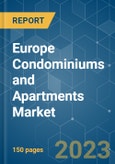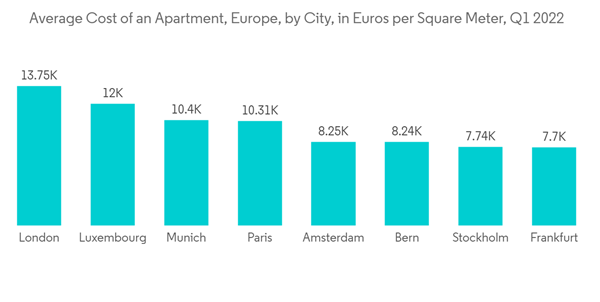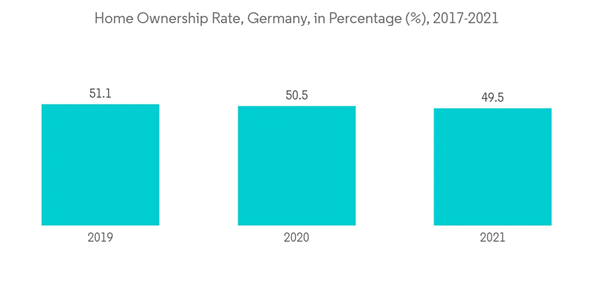Key Highlights
- Europe is on the verge of a significant slowdown in the real economy and the underlying real estate markets. With real estate capital values already falling, 2023 could be an excellent time to buy for core investors who are still under-allocated into the sector. With inflation and rising interest rates, the real estate market is not looking promising for investors. The war in Ukraine has impacted Europe's market, and the real estate industry may deal with the economic and political fallout for the foreseeable future. While industry leaders believe Russia's invasion of Ukraine will have little direct impact on their property portfolios, the war's consequences are visible.
- There is a widespread belief that high energy prices and a recession will cause vacancies and rents to fall. However, real estate companies are not as leveraged as they were before the global financial crisis, owing to regulatory changes over the last decade. Thus, a 5-10% inflation rate in some markets and the threat of stagflation may continue to dampen investor demand in 2023. Due to a disastrous "mini-budget" and a cost-of-living crisis, the British property market activity stalled in October 2022, and house price growth registered its slowest quarterly level since February 2020. The spike in mortgage rates in the aftermath of the Truss plan led to a sharp decline in housing activity. The real estate group Zoopla stated that it was "more pronounced in new buyer demand than sales agreed." Buyer demand fell by 44% Y-o-Y in October 2022, while sales volumes fell by 28% Y-o-Y but remained on par with the pre-pandemic period.
- Due to a lack of available housing, Germany's housing prices continue to rise, albeit at a slower pace. Apartment prices increased by 5.84% Y-o-Y till Q1 2022, following increases of 7.68% in Q4 2021, 8.96% in Q3 2021, 11.68% in Q2 2021, and 9.59% in Q1 2021. Ultra-low borrowing costs, urbanization, healthy household finances, and strong economic growth have boosted the demand. Years of extremely low-interest rates have made it simple for households to upgrade to larger, more expensive homes and for first-time buyers to get on the property ladder. The migration crisis has added to the already high demand in recent years.
- After a five-year boom, the French housing market is showing signs of slowing, with rising interest rates and tighter lending standards reducing sales demand. According to data from France's National Institute of Statistics and Economic Studies, second-hand property price growth slowed in Q2 2022, while real estate developers reported a sharp decline in demand for new housing in October 2022. In Belgium, in the medium term, the number of households is expected to rise over the next decade, supporting demand and, to some extent, prices. Belgians generally have a strong belief in the housing market's stability, which reduces the likelihood of a significant price correction. Even during the financial crisis, when house prices in several European countries plummeted, Belgian house prices experienced only a minor correction.
Europe Condominiums and Apartments Market Trends
Demand for Affordable Housing
- The cost of living, combined with inflation, has significantly impacted citizens throughout Europe. It is also clear that there is no single solution to the problem. Each European country has taken a different approach to addressing the issue and providing people with safe and livable housing. Affordable housing is provided to Belgians with low incomes, whether individuals or families. The system is mostly concentrated in the Brussels, Flemish, and Walloon regions, which have large communities and job opportunities. Affordability accounts for approximately 6.5% of the housing market or 280,000 units. Instead of increasing supply, the country is focusing on renovating existing structures.
- The United Kingdom struggled to meet its ambition of 300,000 new homes per year due to the pandemic. In 2021, 216,000 new homes were built, compared to 243,000 in 2021. About 17% of the market is made up of affordable housing options. There is currently a backlog of citizens living in unsuitable housing and facing affordability challenges. According to the National Housing Federation, 340,000 new homes are needed each year to meet demand, with a minimum of 145,000 affordable solutions.
- The issue of affordable housing is unique to each country in Europe. Some are responding to the situation by launching new initiatives as part of the economic recovery strategy, while others are focused on renovating existing structures to improve living conditions for current residents. However, house prices have risen in recent years due to a shift in investor attitudes. Further, residential property is becoming more popular as an investment asset class in Europe.
Increase in Demand for Rental Properties
- In Europe, the cost of living is rising, as portrayed by the HousingAnywhere data. Living in the region is becoming more expensive, with rent prices for almost all property types in Europe increasing since 2021. Apartment prices are showing the steepest increase, with studios "catching up fast," according to the company's International Rent Index Report for Q4 2021. From 2020 to 2021, the price of apartments in Berlin increased by 40%. Europe is a notoriously expensive place to study. Paris, Zurich, Geneva, and Copenhagen have made the list of the top 10 most expensive cities in the world in 2021, with this figure expected to rise steadily over the next few years.
- Rental prices for all types of student housing in Europe increased in Q3 2021. While some students were willing to pay for this, many were forced to postpone their studies due to a lack of affordable housing. This requires stakeholders such as municipalities, universities, property developers, and technology providers to collaborate to find short-term and long-term solutions to Europe's housing crisis. The European housing crisis is not new. Before the pandemic began, Europeans spent more than 40% of their income on housing. Many people were forced to leave densely populated cities because they could no longer afford the rising cost of living.
- Previously, European cities attempted to address this by regulating markets through price caps, which was not entirely successful. In April 2021, Berlin abolished its rent cap, allowing landlords to demand higher rents or make back payments on existing leases. Spain is experiencing a strong quarterly increase in rent prices due to the market's low supply. Rent prices in the Netherlands have not risen as sharply, but the Y-o-Y increase is still "very prominent."
Europe Condominiums and Apartments Industry Overview
The European condominiums and apartments market is fragmented with the presence of a large number of local and regional players, as well as global players. The major players include Mansion Global, Proprietes Le Figaro, Places for People Group Limited, Sotheby's International Realty Affiliates LLC, and LEG Immobilien AG. The demand for affordable housing and multi-family residential real estate is driving the market, and the existing players need to invest in this segment to sustain. Local players can also hold a good share of the market by investing.Additional Benefits:
- The market estimate (ME) sheet in Excel format
- 3 months of analyst support
This product will be delivered within 2 business days.
Table of Contents
Companies Mentioned (Partial List)
A selection of companies mentioned in this report includes, but is not limited to:
- Elm Group
- Vonovia SE
- Places for People Group Limited
- Castellum AB
- LEG Immobilien AG
- Consus Real Estate AG
- CPI Property Group
- Aroundtown Property Holdings
- Segro
- Altarea Cogedim
- Covivio
- Unibail-Rodamco
- Gecina*










